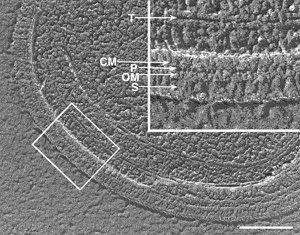Synechococcus and Biofuel: Difference between revisions
Cyoung9350 (talk | contribs) |
Cyoung9350 (talk | contribs) |
||
| Line 12: | Line 12: | ||
===Envrionment & Lifecycle=== | ===Envrionment & Lifecycle=== | ||
<i>Synechococcus</i> are found in both the coastal marine environment as well as the pelagic zone (open sea). The environment in which these cyanobacteria are found in is important to regulation of their cell cycles, as factors such as light-dark cycle can affect <i>Synechococcus</i> cell cycles. <i>Synechococcus</i> has 2 modes of cell cycle regulation. The first mode was consistent with the slow-growth model of the prokaryotic cell cycle. The second mode involved unsynchronized chromosome replication, with variability in chromosome copies amongst cells. The second mode serves as a poor estimator of colony growth rate due to the variation in distribution of DNA in the cells. [http://aem.asm.org/content/61/2/708.full.pdf+html[ | <i>Synechococcus</i> are found in both the coastal marine environment as well as the pelagic zone (open sea). The environment in which these cyanobacteria are found in is important to regulation of their cell cycles, as factors such as light-dark cycle can affect <i>Synechococcus</i> cell cycles. Gaps in DNA synthesis are found between groups of cells that were exposed to light and exposed to dark. It has been determined that the <i>Synechococcus</i> cell cycle is light-dependent. [http://aem.asm.org/content/55/2/425.full.pdf+html[8]] <i>Synechococcus</i> has 2 modes of cell cycle regulation. The first mode was consistent with the slow-growth model of the prokaryotic cell cycle. The second mode involved unsynchronized chromosome replication, with variability in chromosome copies amongst cells. The second mode serves as a poor estimator of colony growth rate due to the variation in distribution of DNA in the cells adding a probalistic component. [http://aem.asm.org/content/61/2/708.full.pdf+html[9]] <i>Synechococcus</i> undergoes all phases of the cell cycle, although the duration of these phases is dependent upon growth rate and environment. Environmental conditions such as presence of nitrogen can affect the doubling time of the colonies as well as the duration of each phase of the cell cycle (S, G1, G2). Liu et al. found in 1999 that when grown under nitrogen-limited conditions, "(1) the fraction of cells in the S and G2 phases relatively constant, and (2) the cellular carbon, nitrogen and pigment content of this strain and their ratios vary with growth rate." [http://www.int-res.com/articles/meps/189/m189p017.pdf[10]] This study illustrated the relationship between physiological characteristics and the cell cycle of <i>Synechococcus</i>, providing greater insight as to better predicting the growth rate of these species. | ||
==Metabolism== | ==Metabolism== | ||
Revision as of 05:09, 13 March 2014
Synechococcus is a genus of unicellular marine cyanobacteria that are found in both freshwater and marine water environments. They comprise a vast majority of picoplanktonic marine cyanobacteria. [1] Species in this genus are capable of photoheterotrophic, chemoheterotrophic, photoautotrophic, and even nitrogen fixation. [2] The genomes of several species of Synechococcus have been fully sequenced, most notably Synechococcus elongatus strain PCC 7942 and species strain WH8102. Due to the diversity in its metabolism as well as a genome that can be readily manipulated, Synechococcus holds potential for biofuel production via these metabolic pathways
Introduction
Classification
Taxonomy
Bacteria; Cyanobacteria; Chroococcales; Synechococcus [3]
Cell Structure
Synechococcus are coccoid shaped bacteria that range in size from 0.2-2 µm. They are classified as Gram-negative cells since the cell envelopes of these cyanobacteria structurally resemble those of Gram-negative bacteria, consisting of a cell membrane, peptidoglycan layer, outer membrane, surface layer, and sometimes additional structures. [4] [5]

] Synechococci species are both motile and non-motile, although many motile species appear to accomplish their movement without the aid of a flagella. Cells are thought to undergo locomotion through a gilding fashion, using filamentous protrusions (pili or spicules) to make contact with cell surfaces and move in a direction parallel to the filament (directional motility). [7] Swimming motility is believed to be accomplished by surface waves generated by filamentous protrusions. It is proposed that the waves are generated by a motor force embedded in the cell membrane, although the exact mechanism is unclear. [6]
Envrionment & Lifecycle
Synechococcus are found in both the coastal marine environment as well as the pelagic zone (open sea). The environment in which these cyanobacteria are found in is important to regulation of their cell cycles, as factors such as light-dark cycle can affect Synechococcus cell cycles. Gaps in DNA synthesis are found between groups of cells that were exposed to light and exposed to dark. It has been determined that the Synechococcus cell cycle is light-dependent. [8] Synechococcus has 2 modes of cell cycle regulation. The first mode was consistent with the slow-growth model of the prokaryotic cell cycle. The second mode involved unsynchronized chromosome replication, with variability in chromosome copies amongst cells. The second mode serves as a poor estimator of colony growth rate due to the variation in distribution of DNA in the cells adding a probalistic component. [9] Synechococcus undergoes all phases of the cell cycle, although the duration of these phases is dependent upon growth rate and environment. Environmental conditions such as presence of nitrogen can affect the doubling time of the colonies as well as the duration of each phase of the cell cycle (S, G1, G2). Liu et al. found in 1999 that when grown under nitrogen-limited conditions, "(1) the fraction of cells in the S and G2 phases relatively constant, and (2) the cellular carbon, nitrogen and pigment content of this strain and their ratios vary with growth rate." [10] This study illustrated the relationship between physiological characteristics and the cell cycle of Synechococcus, providing greater insight as to better predicting the growth rate of these species.
Metabolism
Discuss various pathways of metabolism
Biofuel Potential and Application
Hydrogen Fuel
Lipid-based Biodiesel
Electrical Fuel Cells
Issues in Current Development
Potential for Mass Production
Future Directions
Further Reading
[Sample link] Ebola Hemorrhagic Fever—Centers for Disease Control and Prevention, Special Pathogens Branch
References
Edited by (Caitlyn Young), a student of Nora Sullivan in BIOL168L (Microbiology) in The Keck Science Department of the Claremont Colleges Spring 2014.
